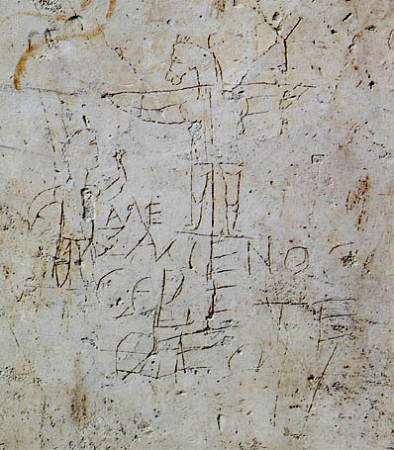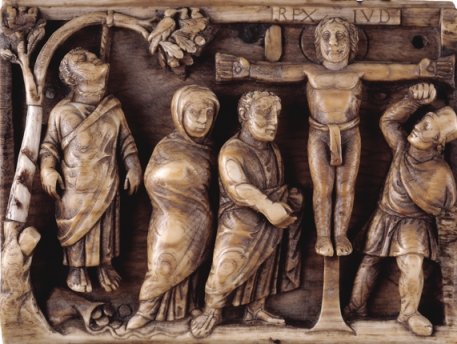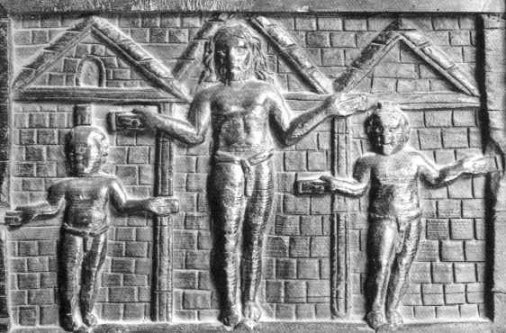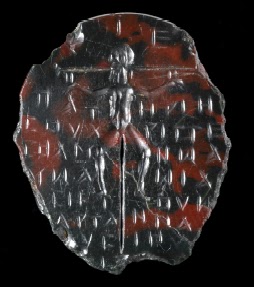|
The
Crucifixion |
|
| The earliest images of the Crucified Christ are quite well known - mainly because there aren't that many of them. These two images vie for the honour of being the oldest. | |
|
|
|
| Actually, there
is no need to compete over this; neither is the earliest known. This
intaglio gemstone (left below) dates from the late second early third
century. It is generally thought to be an amulet or good luck charm.
These would normally feature a pagan image, and no-one seems to be able
to work out why there is a crucifixion scene on it. The Christian church
of the time, it seems, did not approve of magical amulets; the most
likely theory is that a Christian thought he would have one
anyway. Perhaps contemporaneous with the amulet is this notorious graffito showing a crucified donkey and the message 'Alexamenos worships God'. It is not clear whether this was anything more than someone winding up a friend - who can tell? |
|
|
|
 |
| The crucifixion
has been the key image of Christianity for a millennia and a half - but
why did it take so long to establish itself? Might the Alexamenos
graffito offer a clue? A mark of shame It needs to be remembered that early Christian art was a means to teach and reassure believers, and 'sell' the faith to others. As the graffito points out, crucifixion was a shameful way to die. The Unique Selling Point of Christianity was the promise of resurrection and eternal life. Images of a painful death didn't square with this. Of course, the early theologians were fully aware of the significance of the Crucifixion. As Cyril of Jerusalem tells us, 'Let them not be ashamed of the Cross of our Saviour, but rather glory in it, for the word of the Cross is unto Jews a stumbling block, and unto Gentiles foolishness, but to us salvation.'* However, this was probably a far too difficult message to put over in art. Christ needed to be portrayed as a powerful teacher and healer who was still living - though not in human form. The suffering and dying human on the cross didn't fit. This explains also the lack of nativity scenes at this time - a helpless babe dependant on his mother wouldn't work either. It also needs to be remembered also that such early Christian art that has survived marked a death - catacomb frescos and sarcophagi - and the focus had to be resurrection. It should be recognised, however, that the cross itself - without the figure of Christ - was an accepted and important symbol by the end of the second century: Tertullian in De Corona Militis (204) describes the already established tradition of marking the sign of the cross on the forehead. There is much debate on the combining Greek letters to form monograms that became Christian symbols. The chi-rho is the most familar (left below) formed from the letters chi (X) and rho (P) - a symbol of Christ made from the first letters of his name. Less well know is the staurogram or tau-rho (right below) formed from the letters tau (T) and rho. It is claimed by Larry W. Hurtado in The Earliest Christian Artefacts: Manuscripts and Christian Origins, that this mongram is a symbol of the crucifixion itself and was used as such from the very beginnings of Christianity. |
|
|
|
|
| So why did things change? One answer may involve St Helena, mother of Constantine, and the legends of her journey to Palestine to discover the True Cross, as told by Eusabius in his Life of Constantine, written c 330 - 339. Maybe the gradual change from symbol of shame to symbol of power and redemption began here. | |
| *13th Catechetical Oration, c350 | |




